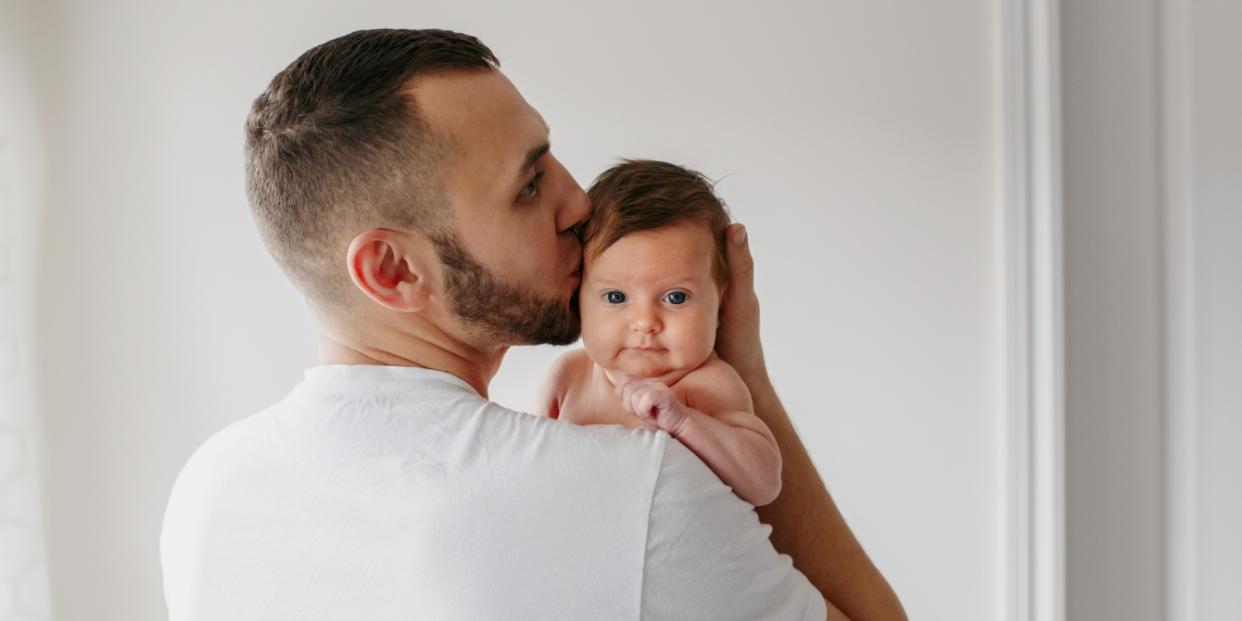Paternity leave benefits the whole family. So why aren’t dads taking it?

Here’s the good news: dads are more involved than ever in childcare and housework. The Pew Research Center reports that dads are spending nearly triple the amount of time on childcare and more than double the amount of time on housework as compared to previous generations.
One of the most crucial times for a dad to be involved is after a baby is born. Research shows that there are far-reaching benefits for the entire family when a dad takes parental leave, including things like faster bonding with the new baby, stronger relationships between parents, a more even distribution of household work and better outcomes for working moms.
“It’s a really critical phase of building that relationship with that child,” Dirk Doebler, CEO and founder of Parento, a paid parental leave insurance company, explains. “It also sets the dynamic for what’s happening in the house and who’s taking on the caregiving burden.”
Terrence Lomeka, who has been with Ernst & Young since 2011, took the full 16 weeks of paid parental leave the company offers new dads. He acted as the primary caregiver after his wife went back to work and says that being the solo parent during that time was invaluable.
“It deepened my gratitude for mothers,” he says, “and helped me understand my wife’s emotions on a whole new level. Our relationship as parents grew stronger and my bond with my child also rapidly grew.”
Beyond improved relationships, moms are more likely to return to work full time when dads have access to parental leave. The financial impact is significant. For every month a dad takes paternity leave, a mom’s income goes up by about 7%.
Doebler explained that when dads don’t take parental leave and moms do, it sets the tone that moms will be the ongoing default parent down the road. That means mom will be more likely to be the one doing things like leaving work earlier to pick up from daycare or the one staying home with a sick child, which makes it harder for women to advance their careers.
“By giving three months of paid parental leave to dads and having them take it so mom can be back to work, you can basically get rid of the parent/non-parent wage gap,” says Doebler.
So what’s the bad news then? Despite all of the documented benefits, many dads aren’t taking paternity leave. Less than half are taking the full benefit available to them.
“Dads at other companies have told me it’s frowned upon to take their full leave,” says Lomeka. “As our jobs are the foundation to provide for our families, I understand why many dads wouldn’t take full leave if they fear it might jeopardize their roles or career trajectory.”
Self proclaimed “Dadvocate” for paid paternity leave and former Google employee Erez Levin also points out that people expect women to take maternity leave, but that’s not always the case for men.
“When a woman goes out [on maternity leave], no one is mad at her,” he remarks. “But the man does have a choice and it’s perceived to be a choice,” which Levin says can mean feeling guilt over leaving teammates with extra work while dads are out.
Levin says that having teammates proactively tell new dads that they want them to take their leave and that their work will be taken care of can go a long way. “As a new dad, the best thing is that everyone on your team is proactively saying ‘we got you,’” he shares.
To get more dads to take parental leave, companies need to go further than just creating a new HR policy. “We need to see more men in leadership and senior roles taking paid parental leave if they’re actually having a child, or advocating telling their employees to take that leave,” urges Doebler.
Seeing leaders and other employees using their available parental leave is one of the best ways to get more dads comfortable using the benefit. Companies who want to help nurture a culture of paternity leave can also do things like celebrate dads who use their leave in meetings.
Lomeka also suggests that highlighting dads who get promoted after coming back from leave can help illustrate that taking parental leave shouldn’t have a negative impact on their careers.
Hearing senior leaders talk positively about dads who take leave, having employees encourage one another to take their leave and seeing colleagues take their leave can all help foster an environment that supports more dads taking time when a new baby is born.
We need more dads to take parental leave. It’s a relatively easy way to help advance working moms’ careers—and has numerous benefits for relationships at home. So if you’re a dad who has taken paternity leave, encourage your colleagues to do the same. If you’re a dad who didn’t take paternity leave or hasn’t yet, help create a positive and supportive environment for new dads to take leave by telling them it’s OK to do so. By publicly acknowledging that support, you’re helping to change the narrative around paternity leave.


